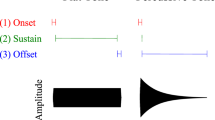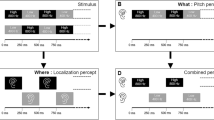Abstract
Three experiments investigated the influence of unambiguous (UA) context tones on the perception of octave-ambiguous (OA) tones. In Experiment 1, pairs of OA tones spanning a tritone interval were preceded by pairs of UA tones instantiating a rising or falling interval between the same pitch classes. Despite the inherent ambiguity of OA tritone pairs, most participants showed little or no priming when judging the OA tritone as rising or falling. In Experiments 2 and 3, participants compared the pitch heights of single OA and UA tones representing either the same pitch class or being a tritone apart. These judgments were strongly influenced by the pitch range of the UA tones, but only slightly by the spectral center of the OA tones. Thus, the perceived pitch height of single OA tones is context sensitive, but the perceived relative pitch height of two OA tones, as described in previous research on the “tritone paradox,” is largely invariant in UA tone contexts.









Similar content being viewed by others
Notes
Experiments 1 and 2 had two sub-experiments each. The chronological sequence of experiments was 1A, 2A, 3, 2B, 1B.
We used musicians as participants because they happened to be readily available, being regular research participants in rhythm and timing experiments in BHR’s lab.
Although we are not concerned here with effects of linguistic background, we might mention that the group was very heterogeneous in that respect: It included native speakers of Cantonese (2), Mandarin (1), Korean (1), German (1), and British English (1), as well as native speakers of American or Canadian English with Chinese, Indian, or partially British parents; only two participants had a purely American linguistic background.
Both authors also had shown positive priming in an earlier pilot run.
One participant (JMT) gave predominantly “falling” responses, whereas two (Ce, Cl1) gave predominantly “rising” responses. Such strong biases towards one or another response are rarely found in the tritone paradox. By intervening between successive OA pairs, the UA pairs may have reduced sequential context effects among OA pairs and thereby disrupted the perceptual calibration that usually occurs during exposure to a set of OA tones.
Linguistic backgrounds were now as follows: Mandarin (2), Cantonese (1), Korean (1), German (1), British (2), American (3).
A few responses that failed to register were also treated as “not sure” responses.
It could also be argued that we did not give participants an opportunity to report high-frequency matches because the fundamental frequency range of our comparison tones extended only to about 1,000 Hz. However, the fact that no UA tone with a fundamental frequency between 500 and 1,000 Hz was ever chosen as a match for an OA tone makes it seem unlikely that even higher tones would have been selected if they had been available as choices.
References
Blake, R., & Logothetis, N. K. (2002). Visual competition. Nature Reviews Neuroscience, 3, 13–21.
Braun, J., & Pastukhov, A. (2007). Further differences between positive and negative priming in the perception of ambiguous patterns. Journal of Vision, 7(9), 368 [abstract].
Cohen, M. A., Grossberg, S., & Wyse, L. L. (1995). A spectral network model of pitch perception. Journal of the Acoustical Society of America, 98, 862–879.
Dawe, L. A., Platt, J. R., & Welsh, E. (1998). Spectral-motion aftereffects and the tritone paradox among Canadian subjects. Perception & Psychophysics, 60, 209–220.
Deutsch, D. (1986). A musical paradox. Music Perception, 3, 275–280.
Deutsch, D. (1987). The tritone paradox—effects of spectral variables. Perception & Psychophysics, 41, 563–575.
Deutsch, D. (1991). The tritone paradox: An influence of language on music perception. Music Perception, 8, 335–347.
Deutsch, D. (1994). The tritone paradox: Some further geographical correlates. Music Perception, 12, 125–136.
Deutsch, D., Henthorn, T., & Dolson, M. (2004). Speech patterns heard early in life influence later perception of the tritone paradox. Music Perception, 21, 357–372.
Deutsch, D., Kuyper, W. L., & Fisher, Y. (1987). The tritone paradox: Its presence and form of distribution in a general population. Music Perception, 5, 79–92.
Fisher, N. I. (1993). Statistical analysis of circular data. New York: Cambridge University Press.
Giangrande, J. (1998). The tritone paradox: Effects of pitch class and position of the spectral envelope. Music Perception, 15, 253–264.
Giangrande, J., Tuller, B., & Kelso, J. A. S. (2002). Perceptual dynamics of circular pitch. Music Perception, 20, 241–262.
Houtsma, A. J. M., & Fleuren, J. F. M. (1991). Analytic and synthetic pitch of two-tone complexes. Journal of the Acoustical Society of America, 90, 1674–1676.
Kanai, R., & Verstraten, F. A. J. (2005). Perceptual manifestations of fast neural plasticity: Motion priming, rapid motion aftereffect and perceptual sensitization. Vision Research, 45, 3109–3116.
Kraus, N., & Banai, K. (2007). Auditory-processing malleability: Focus on language and music. Current Directions in Psychological Science, 16, 105–110.
Krumhansl, C. L., & Iversen, P. (1992). Perceptual interactions between musical pitch and timbre. Journal of Experimental Psychology: Human Perception and Performance, 18, 739–751.
Leopold, D. A., & Logothetis, N. K. (1999). Multistable phenomena: changing views in perception. Trends in Cognitive Science, 3, 254–264.
Luo, F., Wang, Q., Kashani, A., & Yan, J. (2008). Corticofugal modulation of initial sound processing in the brain. Journal of Neuroscience, 28, 11615–11621.
Pearson, J., & Clifford, C. W. G. (2005). Mechanisms selectively engaged in rivalry: normal vision habituates, rivalrous vision primes. Vision Research, 45, 707–714.
Pitt, M. A. (1994). Perception of pitch and timbre by musically trained and untrained listeners. Journal of Experimental Psychology: Human Perception and Performance, 20, 976–986.
Preisler, A. (1993). The influence of spectral composition of complex tones and of musical experience on the perceptibility of virtual pitch. Perception & Psychophysics, 54, 589–603.
Pressnitzer, D., & Hupé, J. M. (2006). Temporal dynamics of auditory and visual bistability reveal common principles of perceptual organization. Current Biology, 16, 1351–1357.
Ragozzine, F. (2001). The tritone paradox and perception of single octave-related complexes. Music Perception, 19, 155–168.
Ragozzine, F., & Deutsch, D. (1994). A regional difference in perception of the tritone paradox within the United States. Music Perception, 12, 213–226.
Repp, B. H. (1994). The tritone paradox and the pitch range of the speaking voice: A dubious connection. Music Perception, 12, 227–255.
Repp, B. H. (1997). Spectral envelope and context effects in the tritone paradox. Perception, 26, 645–665.
Schouten, J., Ritsma, R., & Cardozo, B. (1962). Pitch of the residue. Journal of the Acoustical Society of America, 34, 1418–1424.
Seither-Preisler, A., Johnson, L., Krumbholz, K., Nobbe, A., Patterson, R., Seither, S., et al. (2007). Tone sequences with conflicting fundamental pitch and timbre changes are heard differently by musicians and nonmusicians. Journal of Experimental Psychology: Human Perception and Performance, 33, 743–751.
Shepard, R. (1964). Circularity in judgments of relative pitch. Journal of the Acoustical Society of America, 36, 2346–2353.
Shepard, R. N. (1983). Demonstrations of circular components of pitch. Journal of the Audio Engineering Society, 31, 641–649.
Sterzer, P., Kleinschmidt, A., & Rees, G. (2009). The neural bases of multistable perception. Trends in Cognitive Science, 13, 310–318.
Sterzer, P., & Rees, G. (2008). A neural basis for percept stabilization in binocular rivalry. Journal of Cognitive Neuroscience, 20, 389–399.
Terhardt, E. (1991). Music perception and sensory information acquisition: Relationships and low-level analogies. Music Perception, 8, 217–240.
Terhardt, E., Stoll, G., Schermbach, R., & Parncutt, R. (1986). Tonhöhenmehrdeutigkeit, Tonverwandtschaft und Identifikation von Sukzessivintervallen [Pitch ambiguity, pitch relatedness, and identification of successive intervals]. Acustica, 61, 57–66.
Terhardt, E., Stoll, G., & Seewann, M. (1982a). Pitch of complex signals according to virtual-pitch theory: Tests, examples, and predictions. Journal of the Acoustical Society of America, 71, 671–678.
Terhardt, E., Stoll, G., & Seewann, M. (1982b). Algorithm for extraction of pitch and pitch salience from complex tonal signals. Journal of the Acoustical Society of America, 71, 679–688.
Acknowledgments
Research supported by National Science Foundation Grant BCS-0642506 to BHR. Coauthor JMT was involved in this research as a volunteer research assistant during her senior year in Yale College. She helped design the experiments, performed data analyses, and wrote a report that was the germ of this article.
Author information
Authors and Affiliations
Corresponding author
Rights and permissions
About this article
Cite this article
Repp, B.H., Thompson, J.M. Context sensitivity and invariance in perception of octave-ambiguous tones. Psychological Research 74, 437–456 (2010). https://doi.org/10.1007/s00426-009-0264-9
Received:
Accepted:
Published:
Issue Date:
DOI: https://doi.org/10.1007/s00426-009-0264-9




